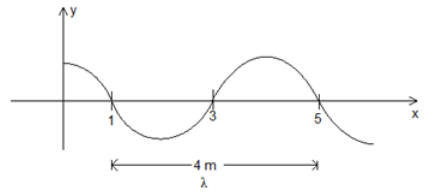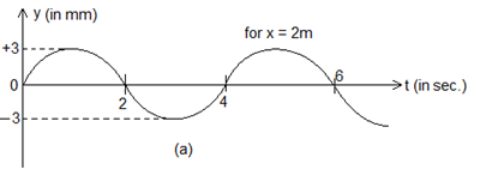12th Grade > Physics
ELECTROMAGNETIC WAVES AND INDUCTION MCQs
Electromagnetic Waves, Electromagnetic Induction, Waves On A String
Total Questions : 73
| Page 6 of 8 pages
Answer: Option B. -> energy
:
B
In a wave, energy travels without any physical transfer of particles.
:
B
In a wave, energy travels without any physical transfer of particles.
Answer: Option D. -> None of these
:
D
Sound waves are mechanical waves i.e., they need material medium to propagate. So they will not travel in vacuum at all! Huh!
:
D
Sound waves are mechanical waves i.e., they need material medium to propagate. So they will not travel in vacuum at all! Huh!
Answer: Option D. -> 4√2mm
:
D
Giventhe frequency and wavelength of the wave is same, the phase method of calculating resultant amplitude can be used. Here given is that phase difference ϕ is π2
Resultant amplitude A=√a21+a22+2a1a2cosϕ
Alsoa1=a2=4mm
A=4√2mm
:
D
Giventhe frequency and wavelength of the wave is same, the phase method of calculating resultant amplitude can be used. Here given is that phase difference ϕ is π2
Resultant amplitude A=√a21+a22+2a1a2cosϕ
Alsoa1=a2=4mm
A=4√2mm
Answer: Option A. -> 1.22 v
:
A
From Hooke's law
Tension in a string (T) ∝ extension (x)
and speed of sound in string v ∝ √T
Therefore, v∝√x
X is increased to 1.5 times i.e., speed will increase by √1.5 times or 1.22 times. Therefore, speed of Sound in new position will be 1.22 v.
:
A
From Hooke's law
Tension in a string (T) ∝ extension (x)
and speed of sound in string v ∝ √T
Therefore, v∝√x
X is increased to 1.5 times i.e., speed will increase by √1.5 times or 1.22 times. Therefore, speed of Sound in new position will be 1.22 v.
Answer: Option D. -> - 0.35 cm
:
D
According to the principle of superposition, each wave produces its disturbance independent of the other and the resultant disturbance is equal to the vector sum of the individual disturbances. The displacements of the particle at x = 4.5 cm at time t = 5.0 ms due to the two waves are,
y1=(1.0cm)sin(3.14cm−1)(4.5cm)−(157s−1)(5.0×10−3s)
=(1.0cm)sin[4.5π−π4]
=(1.0cm)sin[4.5π−π4]=1.0cm√2
and
y2=(1.5cm)sin[(1.57cm−1)(4.5cm)−(314s−1)(5.0×10−3s)]
= (1.5cm)sin[2.25π−π2]
= (1.5cm)sin[2π−π4]
= −(1.5cm)sinπ4=−1.5cm√2
The net displacment is
y=y1+y2=−0.5cm√2=−0.35cm
:
D
According to the principle of superposition, each wave produces its disturbance independent of the other and the resultant disturbance is equal to the vector sum of the individual disturbances. The displacements of the particle at x = 4.5 cm at time t = 5.0 ms due to the two waves are,
y1=(1.0cm)sin(3.14cm−1)(4.5cm)−(157s−1)(5.0×10−3s)
=(1.0cm)sin[4.5π−π4]
=(1.0cm)sin[4.5π−π4]=1.0cm√2
and
y2=(1.5cm)sin[(1.57cm−1)(4.5cm)−(314s−1)(5.0×10−3s)]
= (1.5cm)sin[2.25π−π2]
= (1.5cm)sin[2π−π4]
= −(1.5cm)sinπ4=−1.5cm√2
The net displacment is
y=y1+y2=−0.5cm√2=−0.35cm
Question 56. On December 2006, a great earthquake occurred off the coast of Sumatra and triggered immense waves (Tsunami) that killed some 200,000 people. Satellites observing these waves from space measured 800 km from one wave crest to the next and a period between waves of 1 hr. what was the speed of the wave?
Answer: Option C. -> 800 km/hr
:
C
crest to crest distance is wavelength λ = 800 km
Time period:Time taken for wave to travel a distance of one wavelength = 1 hr
Wave velocity = DistanceTime=1wavelength(λ)Timeperiod(T)
800km1=800km/hr
:
C
crest to crest distance is wavelength λ = 800 km
Time period:Time taken for wave to travel a distance of one wavelength = 1 hr
Wave velocity = DistanceTime=1wavelength(λ)Timeperiod(T)
800km1=800km/hr
Answer: Option C. -> 4m, 0.25 Hz, 1 ms−1, 1.5 πmms−1, 0.75 π2mms−2
:
C
From the y-t graph we can see the wave repeats itself on interval of 4s. So the time period is 4s. from the y-x graph we see that the distance between the points after which the wave repeats itself is 4m. Hence the wave length is 4m.


f=1T=14S−1=0.25s−1
v=λf=414=1ms−1
vpmax=Aω
=A×(2πf
=3××2π×0.25 [A=3 from y vst graph]
apmax=ω2A
=(2π×0.25)2×3
34π2=0.075π2mms−2
:
C
From the y-t graph we can see the wave repeats itself on interval of 4s. So the time period is 4s. from the y-x graph we see that the distance between the points after which the wave repeats itself is 4m. Hence the wave length is 4m.


f=1T=14S−1=0.25s−1
v=λf=414=1ms−1
vpmax=Aω
=A×(2πf
=3××2π×0.25 [A=3 from y vst graph]
apmax=ω2A
=(2π×0.25)2×3
34π2=0.075π2mms−2
Answer: Option B. -> A sin[x−v(t−t0)a]
:
B
Here given is g(x,t0)=Asin(xa) at t=t0
Comparing with the general equation g(x,t)=Asin(kx−ωt+ϕ)
We get at t=t0
k=1a
also−ωt0+ϕ=0
⇒ϕ=ωt0
We also known that k=ωv
⇒ω=va
so we get
g(x,t)=Asin(xa−vta+vt0a)
g(x,t)=Asin[xa−vta+vt0a]
=Asin(x−v(t−t0)a)
:
B
Here given is g(x,t0)=Asin(xa) at t=t0
Comparing with the general equation g(x,t)=Asin(kx−ωt+ϕ)
We get at t=t0
k=1a
also−ωt0+ϕ=0
⇒ϕ=ωt0
We also known that k=ωv
⇒ω=va
so we get
g(x,t)=Asin(xa−vta+vt0a)
g(x,t)=Asin[xa−vta+vt0a]
=Asin(x−v(t−t0)a)
Answer: Option B. -> 0.10 s
:
B
Mass per unit length of the string,
m=10−20.4=2.5×10−2 kg/m
∴ Velocity of wave in the string.
v=√Tm=√1.62.5×10−2
v=8m/s
For constructive interference between successive pulses:
△tmin=2lv=(2)(0.4)8=0.10s
(After two reflections, the wave pulse is in same phase as it was produced, since in one reflection its phase changes by π and if at this moment next identical pulse is produced, then constructive interference will be obtained.)
:
B
Mass per unit length of the string,
m=10−20.4=2.5×10−2 kg/m
∴ Velocity of wave in the string.
v=√Tm=√1.62.5×10−2
v=8m/s
For constructive interference between successive pulses:
△tmin=2lv=(2)(0.4)8=0.10s
(After two reflections, the wave pulse is in same phase as it was produced, since in one reflection its phase changes by π and if at this moment next identical pulse is produced, then constructive interference will be obtained.)
Answer: Option B. -> -a
:
B
y=Ae−(xa+tT)2
at t=T the pulse would be
y=Ae−(xa+1)2
dydx=−2Aa(xa+1)e−(xa+1)2
dydx=0⇒xa+1=0
x=−a
:
B
y=Ae−(xa+tT)2
at t=T the pulse would be
y=Ae−(xa+1)2
dydx=−2Aa(xa+1)e−(xa+1)2
dydx=0⇒xa+1=0
x=−a


















